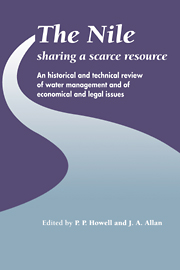 The Nile: Sharing a Scarce Resource
The Nile: Sharing a Scarce Resource Book contents
- Frontmatter
- Contents
- Preface
- List of Contributors
- Orthography
- Units and Conversion Factors
- Introduction
- I Environmental history of the Nile and its management
- II Nile management and factors affecting future management
- III Future utilisation of Nile waters
- 8 Future irrigation planning in Egypt
- 9 Future water development planning in the Sudan
- 10 Irrigation and hydro-power potential. Water needs in Uganda, an overview
- 11 The integrated development of Nile waters
- 12 The control of the swamps of the southern Sudan: Drainage schemes, local effects and environmental constraints on remedial development
- 13 Water balance of the Bahr el Ghazal swamps
- IV Economic, international and legal issues
- Index
12 - The control of the swamps of the southern Sudan: Drainage schemes, local effects and environmental constraints on remedial development
Published online by Cambridge University Press: 05 February 2012
- Frontmatter
- Contents
- Preface
- List of Contributors
- Orthography
- Units and Conversion Factors
- Introduction
- I Environmental history of the Nile and its management
- II Nile management and factors affecting future management
- III Future utilisation of Nile waters
- 8 Future irrigation planning in Egypt
- 9 Future water development planning in the Sudan
- 10 Irrigation and hydro-power potential. Water needs in Uganda, an overview
- 11 The integrated development of Nile waters
- 12 The control of the swamps of the southern Sudan: Drainage schemes, local effects and environmental constraints on remedial development
- 13 Water balance of the Bahr el Ghazal swamps
- IV Economic, international and legal issues
- Index
Summary
Introduction
Much of the current debate on the Nile and the distribution of its waters has centred on the recent shortfalls in Blue Nile flows owing to poor rainfall in the Ethiopian catchment and the possibility of this being a long-term or even permanent climatic feature. This and growing demand occasioned by population increase in Egypt and the Sudan naturally focuses attention on the potential of catchments other than that of the Blue Nile system and with which there is not necessarily any climatic correlation. High levels in Lake Victoria and increased discharges in the White Nile from the East African catchment during the last three decades and the possibility of increased rainfall in that area (see Chapter 6) therefore tend to reinforce interest in as yet very tentative schemes to reduce losses from evaporation and transpiration in the Sudd and neighbouring wetlands. These include the current Jonglei Canal Stage I now halted by the present civil war, and the projected Jonglei Canal Stage II, which will double the canal capacity.
There are also major canalisation schemes planned for two other swamplands where huge losses by evapo-transpiration occur, but neither of which draws its water from the White Nile catchment in East Africa. The first we refer to as the South-Western area, which includes the Bahr el Ghazal basin. This receives water from the Nile-Congo divide, virtually none of which ever reaches the Nile, and from rainfall which has no correlation with that from which the Bahr el Jebel and the Sudd derives.
- Type
- Chapter
- Information
- The Nile: Sharing a Scarce ResourceA Historical and Technical Review of Water Management and of Economical and Legal Issues, pp. 243 - 280Publisher: Cambridge University PressPrint publication year: 1994
- 1
- Cited by
